How to Grow a Sesame Plant: Essential Tips from Seed to Harvest
- March 5, 2024
- 0 comment
Sesame (Sesamum indicum) is a flowering plant renowned for its seeds, which are a staple in cuisines worldwide. Originating in Africa and India, sesame has been cultivated for thousands of years. Its seeds are highly valued for their oil-rich quality, making them an essential ingredient in various dishes and for medicinal purposes. This guide provides a comprehensive look into growing sesame plants, ensuring a bountiful and healthy harvest.
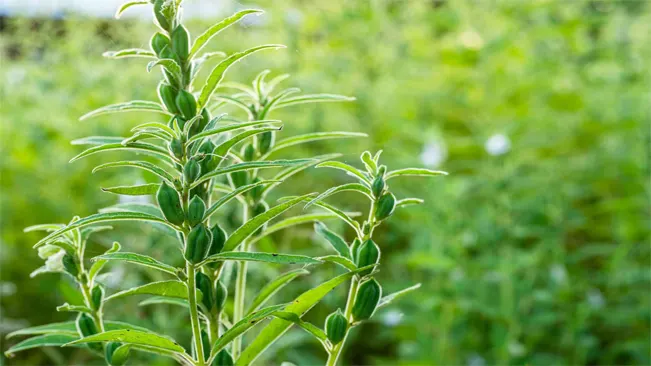
Benefits of Sesame Plants
| Benefit | Description |
|---|---|
| Nutritional Value | Sesame seeds are a rich source of protein, healthy fats, vitamins (B1, B2, B3), minerals (calcium, magnesium, phosphorus, iron), and dietary fiber. |
| Health Benefits | Promotes heart health, aids in digestion, supports healthy bones, has anti-inflammatory and antioxidant properties, and may help in managing blood pressure. |
| Skin and Hair Care | Sesame oil is known for its nourishing and moisturizing properties, beneficial for skin and hair health. It can also have anti-aging effects and promote hair growth. |
| Culinary Uses | The seeds are used in a variety of cuisines for their nutty flavor. They can be added to bread, salads, baked goods, and more. Sesame oil is popular in cooking as well. |
| Medicinal Uses | Traditional medicine uses sesame seeds and oil for their potential to relieve pain, support respiratory health, and improve sleep. |
| Economic Importance | Sesame is a valuable crop for oil production and is a significant source of income for small-scale farmers in many developing countries. |
| Environmental Benefits | Sesame plants are drought-resistant and can grow in poor soils, making them suitable for sustainable agriculture and improving soil health in less fertile regions. |
| Cultural Significance | Sesame seeds have cultural importance in various societies, used in rituals, ceremonies, and traditional dishes, symbolizing prosperity and health in some cultures. |
List on How To Grow Sesame Plant
- Understanding Sesame Plants
- Climate and Soil Requirements
- Sowing Sesame Seeds
- Caring for Sesame Plants
- Pest and Disease Management
- Harvesting
Understanding Sesame Plants
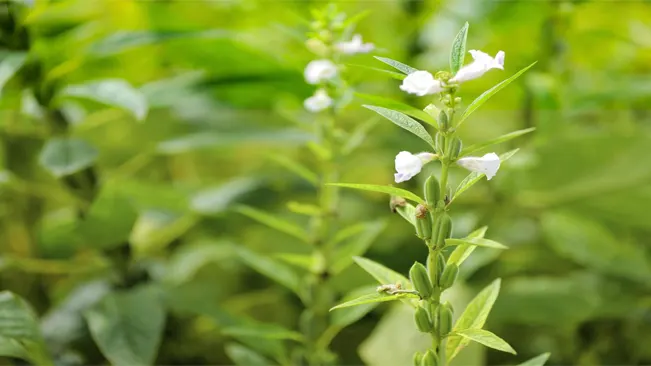
- Before delving into the cultivation process, it’s crucial to understand the characteristics of the sesame plant. It’s an annual plant growing up to 60 cm to 1 meter tall, with slender, oblong leaves and tubular flowers that vary in color from white to pink. The plants are notable for their ability to grow in conditions where many other crops fail, making them a valuable crop in arid and semi-arid regions.
Climate and Soil Requirements
Sesame plants thrive in warm climates with temperatures between 20°C to 30°C. They are sensitive to frost and excessive moisture. The ideal growing conditions include a well-drained soil, preferably sandy loam, with a neutral pH. Good drainage is critical as the plant is susceptible to root rot in waterlogged soil.
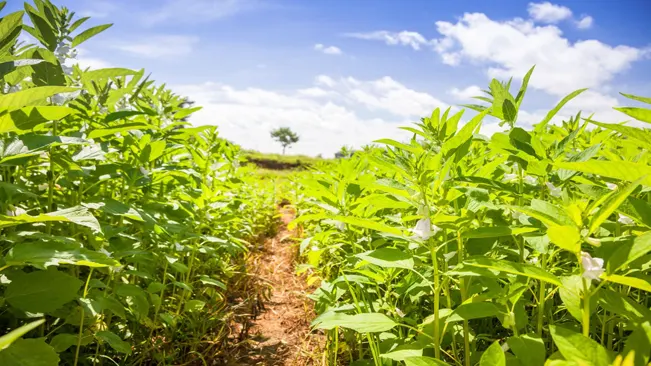
Climate Requirements
- Temperature Range: Sesame plants thrive best in warm climates. The ideal temperature range is between 20°C to 30°C (68°F to 86°F). They require a long growing season with plenty of sunlight. In regions with cooler climates, growing sesame might be challenging due to their sensitivity to lower temperatures.
- Frost Sensitivity: Sesame plants are particularly sensitive to frost. Even a light frost can damage or kill the plants. This sensitivity necessitates planting after all danger of frost has passed and ensuring the growing season is long enough for the plants to mature and produce seeds.
- Sunlight Exposure: These plants require full sun exposure for optimum growth. A minimum of 6 to 8 hours of direct sunlight per day is necessary. The high sunlight requirement contributes to the plant’s ability to produce abundant seeds.
- Rainfall and Humidity: While sesame plants can tolerate dry conditions, they do need some moisture, especially during the germination and early growth stages. However, excessive moisture, particularly in the form of high humidity or prolonged rainy periods, can be detrimental. It can lead to fungal diseases and negatively impact seed development.
Soil Requirements
- Soil Type: The best soil type for sesame is well-drained sandy loam. This type of soil provides adequate drainage while retaining sufficient moisture and nutrients. Sesame plants are adaptable and can tolerate a range of soil types as long as drainage is good.
- Soil pH: A neutral pH is ideal for sesame cultivation. Generally, a pH range of around 5.5 to 7.0 is suitable. If the soil is too acidic or alkaline, it might be necessary to adjust the pH to fall within this range for optimal growth.
- Drainage: Good drainage is crucial for sesame plants. They are particularly susceptible to root rot and other fungal diseases if the soil is waterlogged. If you’re planting in an area with heavy or clay soil, consider raising the beds or amending the soil with organic matter to improve drainage.
- Soil Fertility: Sesame does not require highly fertile soil. Over-fertilization, especially with nitrogen, can lead to lush vegetative growth at the expense of seed production. If the soil is very poor, a balanced, low-strength fertilizer can be applied at planting.
- Soil Preparation: Before planting, it’s beneficial to loosen the soil to a depth of several inches and remove any debris or large clumps. This preparation helps with root penetration and water distribution throughout the soil.
Sowing Sesame Seeds
Choosing the Right Time
- Sesame seeds should be sown during the warm season, typically late spring or early summer, depending on your geographical location. The key is to ensure that the soil temperature is warm enough, ideally around 70°F (21°C), as sesame seeds require warmth for germination and growth. Planting too early in cooler soil can lead to poor germination.
Preparing the Soil
- Before sowing, prepare the soil by tilling or loosening it to a depth of several inches. This preparation ensures good soil aeration and drainage, which are crucial for sesame seed germination and root development. If your soil is heavy or clayey, consider adding organic matter to improve its structure.
Sowing Technique
- Sow the seeds directly into the ground, as sesame does not transplant well. Plant the seeds at a depth of about 0.75 to 1 inch. This depth is optimal to ensure that the seeds have enough soil coverage to retain moisture but are not so deep that they cannot emerge. Space the seeds 3 to 4 inches apart in rows. This initial close spacing helps with weed control and ensures that some plants will germinate and grow even if some seeds fail.
Watering After Sowing
- After sowing, water the area gently but thoroughly. The soil should be kept moist but not waterlogged. Over-watering can cause the seeds to rot. A light, consistent moisture level in the soil is ideal until germination occurs.
Germination Period
- Sesame seeds typically germinate within 7 to 14 days after planting, depending on soil temperature and moisture. During this period, it’s important to keep the soil consistently moist.
Thinning Seedlings
- Once the seedlings are a few inches tall and have at least one set of true leaves, it’s time to thin them. Thinning involves removing some seedlings to allow the remaining ones enough space to grow. Thin the plants to about 12 inches apart. This spacing gives each plant sufficient space to grow, ensures adequate airflow, and reduces competition for nutrients and water.
Post-Thinning Care
- After thinning, continue to care for the sesame plants by maintaining soil moisture, especially in dry conditions, and weeding regularly. Sesame plants have a relatively shallow root system, so care should be taken not to disturb the roots when weeding.
Caring for Sesame Plants
Sesame plants require minimal care. They are drought-tolerant once established, needing occasional deep watering. Over-watering should be avoided. Fertilization is not usually necessary, but a light application of a balanced fertilizer can be beneficial at the planting stage. Regular weeding is essential to prevent competition for nutrients.
Watering
- Deep Watering: Sesame plants prefer deep, infrequent watering. This encourages the roots to grow deeper into the soil, which helps the plant become more drought-tolerant.
- Avoid Over-watering: Sesame plants are sensitive to excessive moisture. Over-watering can lead to root diseases like root rot. It’s important to let the soil dry out between watering sessions.
- Monitoring: The top inch of the soil should be dry before you water again. During hot and dry conditions, more frequent watering may be necessary.
Fertilization
- At Planting Stage: A light application of a balanced fertilizer (like a 10-10-10 NPK) can be applied at the time of planting. This provides the initial nutrients needed for growth.
- Minimal Need: Sesame plants are not heavy feeders. Excessive fertilization, especially nitrogen, can lead to lush foliage at the expense of seed production.
- Organic Options: If preferred, organic fertilizers like compost or well-rotted manure can be used. They provide nutrients slowly and improve soil structure.
Weeding
- Regular Weeding: Sesame plants compete with weeds for nutrients and water. Regular weeding is essential, especially in the early stages of growth.
- Mulching: Applying a layer of organic mulch around the plants can help suppress weed growth, retain soil moisture, and regulate soil temperature.
- Careful Cultivation: When weeding or cultivating around sesame plants, be gentle to avoid disturbing the roots.
Pest and Disease Management
- Monitoring: Regularly inspect plants for signs of pests or disease. Early detection is key to effective management.
- Natural Predators: Encourage beneficial insects that prey on common pests like aphids.
- Good Air Circulation: Ensure plants are spaced properly and the growing area is well-ventilated to prevent fungal diseases.
Support
- Staking: In windy areas or where plants grow particularly tall, staking may be necessary to prevent plants from falling over.
Climate Considerations
- Frost Protection: Sesame plants are sensitive to frost. If an unexpected late frost is forecasted, covering the plants overnight can provide protection.
Pest and Disease Management
While relatively hardy, sesame plants can be susceptible to pests like aphids and diseases such as leaf spot and root rot. Monitoring and early intervention are key. Using organic pesticides and ensuring good air circulation around plants can help prevent these issues.
Pest Management in Sesame Plants
- Aphids:
- Identification: Small, soft-bodied insects that can be green, black, brown, or pink. They usually cluster on the underside of leaves and stems.
- Control: You can use organic insecticidal soaps or neem oil to control aphids. Introducing natural predators like ladybugs into your garden can also help.
- Other Pests:
- Sesame might occasionally attract other pests like leafhoppers and spider mites.
- Control: Similar to aphids, these can be managed with insecticidal soaps, neem oil, and natural predators.
Disease Management in Sesame Plants
- Leaf Spot:
- Identification: Small, dark spots on leaves that can grow and merge, causing the leaves to yellow and drop off.
- Prevention and Control: Ensure good air circulation, avoid overhead watering to keep foliage dry, and remove any affected leaves promptly. Fungicides can be used if necessary, but it’s best to opt for organic options.
- Root Rot:
- Identification: Stunted growth, wilting, and yellowing of leaves, often caused by over-watering and poor drainage.
- Prevention and Control: Ensure good drainage in your soil, water plants carefully, and avoid over-watering. If root rot is suspected, reduce watering and improve soil conditions if possible. In severe cases, affected plants should be removed to prevent the spread.
General Tips for Pest and Disease Management in Sesame Plants
- Regular Monitoring: Early detection of pests and diseases is key. Regularly inspect your plants for signs of trouble.
- Cultural Practices: Good cultural practices such as crop rotation, proper spacing, and maintaining garden hygiene can significantly reduce pest and disease problems.
- Organic Pesticides and Fungicides: Whenever possible, use organic products to deal with pests and diseases. They are less harmful to the environment and beneficial insects.
- Encourage Beneficial Insects: Encouraging beneficial insects like ladybugs, lacewings, and bees can help in naturally controlling pest populations.
Harvesting
Sesame seeds are ready to harvest when the seed pods turn brown and begin to crack open. This usually occurs about 90 to 150 days after planting. Harvesting is done manually by cutting the entire plant and hanging it upside down in a warm, dry place to allow the seeds to dry and fall out.
Timing of Harvest
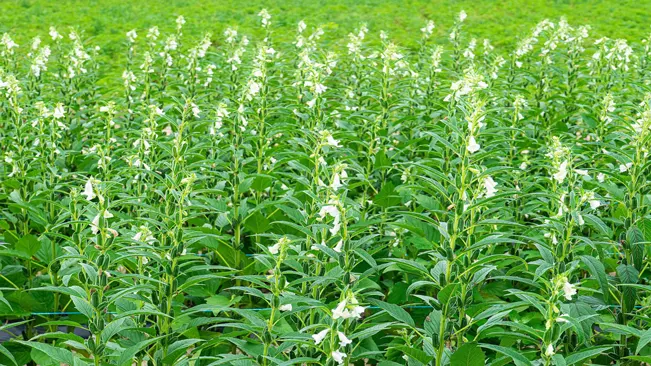
- Sesame seeds are ready to harvest when they reach maturity, which is typically around 90 to 150 days after planting. The exact timing can vary based on the climate, soil, and sesame variety.
- The key indicator that sesame seeds are ready for harvest is the color and condition of the seed pods. The pods turn from green to a brown or tan color and begin to crack open slightly. This cracking is a natural process as the seeds dry out.
Harvesting Method
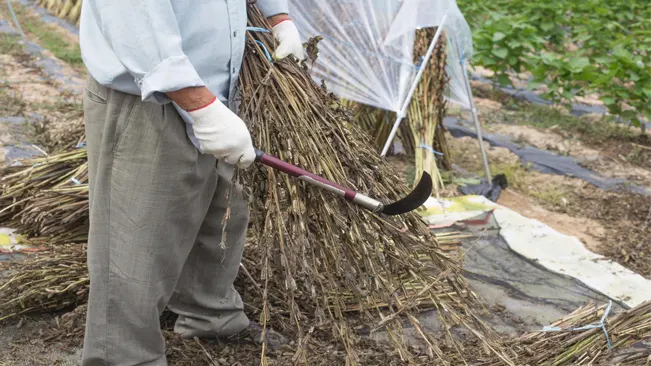
- Harvesting sesame plants is generally done manually due to the delicate nature of the seed pods. The plants are cut close to the ground using a sharp tool like scissors or a sickle.
- Care must be taken during harvesting to prevent the seed pods from shattering and losing the seeds.
Post-Harvest Handling
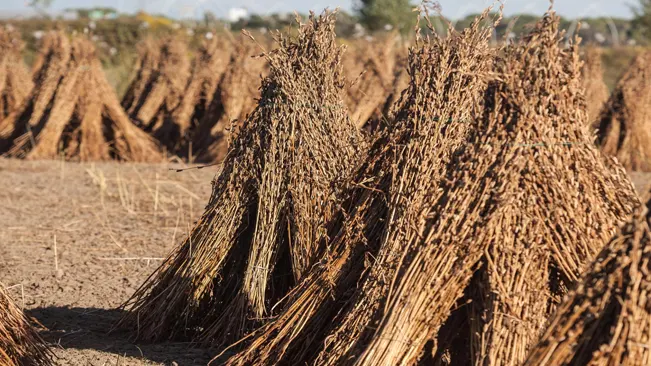
- After harvesting, the sesame plants are typically bundled and hung upside down. This is done in a warm, dry place, like a shed or under a canopy, to protect them from moisture and rain.
- Hanging the plants upside down helps the seeds to continue drying and makes it easier for them to fall out of the pods.
- The drying process is crucial. It can take several weeks for the seeds to dry thoroughly. The seeds must be completely dry before storage to prevent mold and spoilage.
Collecting the Seeds
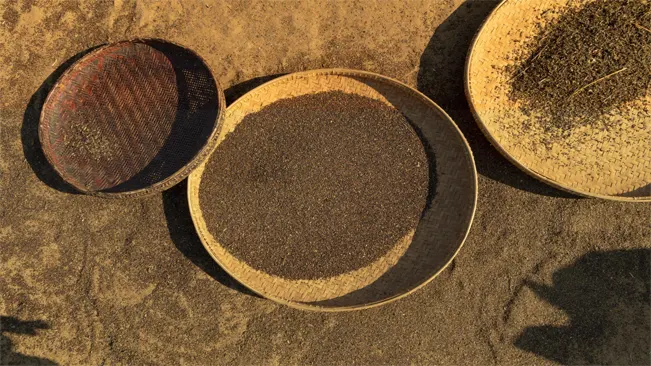
- Once the seeds are dry, the pods are shaken or beaten gently to release the seeds. This can be done by hand or with the help of tools.
- The seeds are then collected and may need to be cleaned to remove any plant debris.
Storage

- Dried sesame seeds should be stored in a cool, dry place. Proper storage is important to maintain their quality and prevent them from going rancid.
- They can be stored in airtight containers to extend their shelf life.
Considerations
- Weather conditions can greatly affect the harvesting process. Rain or high humidity during harvest can cause the pods to rot or the seeds to mold.
- Some farmers may choose to harvest a bit earlier if there’s a risk of bad weather, though this can result in lower oil content in the seeds.
Conclusion
Growing sesame is a rewarding endeavor. It requires minimal effort but offers valuable returns in the form of nutritious and versatile seeds. Whether for culinary use or as a crop in your garden, sesame is a plant that is as resilient as it is beneficial. Embrace the challenge of growing this ancient plant and enjoy the rich rewards it brings.
FAQs (Frequently Asked Questions)
- What is the best time to plant sesame seeds?
- Sesame seeds should be planted after the last frost when the soil has warmed up, typically in late spring or early summer.
- Sesame seeds should be planted after the last frost when the soil has warmed up, typically in late spring or early summer.
- What type of soil is ideal for sesame plants?
- Sesame plants prefer well-drained, fertile soil with a neutral pH. Sandy loam soil is ideal.
- Sesame plants prefer well-drained, fertile soil with a neutral pH. Sandy loam soil is ideal.
- How much sun do sesame plants need?
- They require full sun, at least 6-8 hours of direct sunlight per day.
- They require full sun, at least 6-8 hours of direct sunlight per day.
- How do you water sesame plants?
- Water them sparingly; they are drought-tolerant. Over-watering can lead to root rot.
- Water them sparingly; they are drought-tolerant. Over-watering can lead to root rot.
- Do sesame plants need a lot of space to grow?
- Space sesame plants about 12 inches apart to allow adequate room for growth.
- Space sesame plants about 12 inches apart to allow adequate room for growth.
- How long does it take for a sesame plant to produce seeds?
- It typically takes around 90 to 150 days from planting to harvest.
- It typically takes around 90 to 150 days from planting to harvest.
- How can I tell when sesame seeds are ready to harvest?
- Harvest when the seed pods turn brown and begin to crack open.
- Harvest when the seed pods turn brown and begin to crack open.
- What are common pests and diseases that affect sesame plants?
- Common issues include aphids, leaf spot, and root rot. Regular monitoring and organic pest control can help manage these.
- Common issues include aphids, leaf spot, and root rot. Regular monitoring and organic pest control can help manage these.
- Can sesame plants be grown in containers?
- Yes, sesame can be grown in containers, provided they are deep enough for root development and have good drainage.
- Yes, sesame can be grown in containers, provided they are deep enough for root development and have good drainage.
- Do sesame plants require fertilization?
- They generally do not require heavy fertilization. A light application of a balanced fertilizer at planting can be beneficial.

Kristine Moore
Forestry AuthorI'm Kristine Moore, a seasoned garden landscaping professional with over 30 years of experience. My extensive career has been dedicated to transforming outdoor spaces into stunning, sustainable landscapes. With a deep understanding of horticulture, design principles, and environmental stewardship, I have become a respected figure in the field, known for creating harmonious, visually appealing, and eco-friendly gardens. My commitment to excellence and continuous learning in landscaping trends and techniques has solidified my reputation as an expert in garden design and implementation.

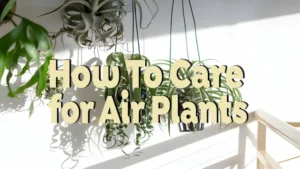







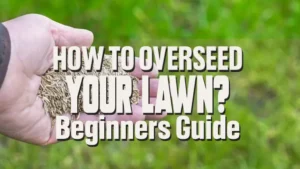


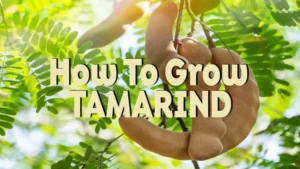
Leave your comment